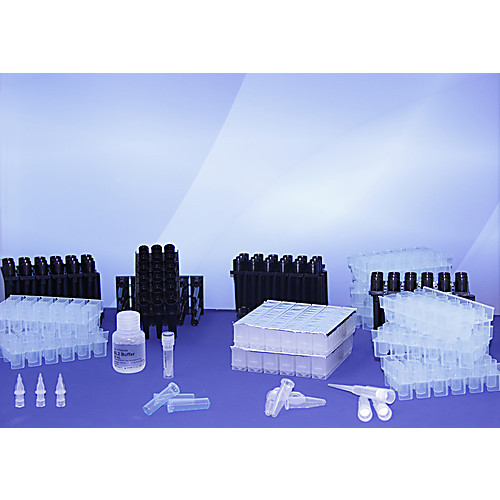Product content:Component:N665859-50T:Buffer DS:30 mL:Buffer GTL:15 mL:Buffer GL:15 mL:Buffer GW1 (concentrate):13 mL:Buffer GW2 (concentrate):15 mL:Buffer TE:10 mL:Proteinase K:2×1.25 mL:RNase A (100 mg/mL):0.4 mL:Spin Columns DF With Collection Tubes:50:Centrifuge Tubes(L-1.5 mL):50:Product Introduction:This kit is suitable for the effective purification of genomic DNA from formalin-fixed, paraffin-embedded tissues.The product uses specially optimized dewaxing agent and lysis solution to release DNA from formalin-fixed or tissue sectioned samples, which does not involve the organic reagent xylene and does not need to be operated overnight: the digested samples are incubated at higher temperatures to remove formalin cross-linking of the free DNA, which can effectively improve the yield and purity of DNA: the optimized buffer system allows the inhibitors in the lysis solution to be specifically bound to the adsorbent membrane, which can be effectively removed by a two-step rinsing step. The optimized buffer system enables the DNA in the lysate to specifically bind to the adsorbent membrane, and the inhibitor is effectively removed by a two-step rinsing step, and finally eluted with low-salt buffer or water to obtain high-purity DNA.Meanwhile, configured with a high-efficiency microsorbent column, the elution volume can be as low as 20 μL.The purified DNA can be directly used for PCR, Real-time PCR, SNP Genotyping, STR genotyping, second-generation sequencing and pharmacogenomics research.The molecular weight of DNA isolated from formalin-fixed, paraffin-embedded samples is usually lower than that of DNA from fresh or frozen samples.The degree of DNA fragmentation depends on the type of sample, the duration of storage, and the conditions of fixation.Self-contained reagent: :anhydrous ethanol:Pre-experiment Preparation and Important Notes:1. After obtaining the sample, fix the sample in 4%-10% formalin as soon as possible, the fixation time should be 14-24 hours, too long a period of time will easily lead to genome breakage, affecting the downstream experiments. If the formaldehyde fixation time is too long or the sample has been stored for too long (>: 1 year), it will easily lead to DNA integrity damage and unable to amplify long fragments.2. Ensure that the sample is thoroughly dehydrated before embedding: residual formalin will inhibit Proteinase K.3. Anhydrous ethanol should be added to Buffer GW1 and Buffer GW2 according to the instructions on the label of the reagent bottle before first use.4. Before use, please check Buffer GTL, Buffer GL and Buffer DS for any crystallization or precipitation. If there is any crystallization or precipitation, please re-dissolve Buffer GTL, Buffer GL and Buffer DS at 56℃ in a water bath.5. Preheat the water bath or thermostatic mixer to 56°C and keep the centrifuge at 25°C before starting the experiment.6. If downstream experiments are needed to reduce the low frequency of C>:T|G>:A transitions (artificial mutations) that occur to minimize the risk of false positives, 7 μL of UNG (1 U/uL) can be added after 1 hour of incubation at 90°C.Operation steps:1. Sample processing:1a. Paraffin-embedded samples: Trim off excess paraffin from the tissue block with a scalpel to expose the tissue and then cut into 5-10µm slices. Take about 1×1cm2 slices (about 4-5 slices in total) and place them in a centrifuge tube (provided), add 160μL Buffer DS, vortex and shake for 10 seconds, then add 180μL Buffer GTL and 20μL Proteinase K, vortex and shake for 10 seconds. centrifuge the samples at 12,000rpm for 1 minute at 25℃.Note: 1) If the surface of the sample has been exposed to air, discard the 2-3 pieces that have been exposed to air and do not use them.2) DS will solidify below 18°C, and if it does it does not affect the following experiments.1b. Sample in formalin and other fixative: take about 20mg of sample, cut it into small pieces, place it in a centrifuge tube, add 500μL of 10mM PBS (PH7.4), vortex shaking, centrifuge at 12,000rpm for 1minute, discard the supernatant, and repeat 3 times. Add 180 μL Buffer GTL, 20 μL Proteinase K, vortex shaking to mix.2.56°C for 1 hour until the sample is completely dissolved. incubate at 90°C for 1 hour. centrifuge at 12,000 rpm, 25°C for 1 minute, and carefully pipette the lower aqueous phase (~180 μL) along the wall of the tube into a new centrifuge tube, trying to avoid aspirating the bottom precipitate and the upper layer of the wax solution.Note: 1) Samples can be left at room temperature after incubation at 56°C until the temperature of the water or dry bath reaches 90°C before placing the samples at 90°C:Incubation.2) Optional step: add 7μL UNG (1U/μL), 50°C, 5min, no shaking. The purpose of this step is to minimize the risk of false positives by reducing the low-frequency occurrence of C>:T|G>:A transitions (artificial mutations) while effectively retaining the true occurrence of mutations.3. Optional step: If you need to remove RNA, you can lower the temperature of the sample to room temperature, then add 2μL of RNase A solution at a concentration of 100mg/mL, shake and mix well, and leave it at room temperature for 2 minutes.4. Add 20μL Proteinase K and incubate at 65℃, 450rpm for 15min.5. Add 200 μL of Buffer GL, mix well by vortexing and shaking, then add 200 μL of anhydrous ethanol and mix thoroughly by vortexing and shaking. Centrifuge briefly so that the solution on the wall of the tube collects at the bottom of the tube.Note: 1) Mix well immediately after adding Buffer GL and anhydrous ethanol.2) The addition of Buffer GL and anhydrous ethanol may produce a white precipitate that will not affect subsequent experiments.3) If more than one sample needs to be manipulated, the Buffer GL and anhydrous ethanol can be pre-mixed and spiked.6. Add all the solution obtained in step 5 to the adsorption columns (Spin Columns DF) that have been loaded into the collection tube, centrifuge at 25℃, 12000rpm for 2 minutes, pour out the waste liquid in the collection tube, and put the adsorption columns back into the collection tube.7. Add 500μL of Buffer GW1 to the adsorption column (check that anhydrous ethanol has been added before use), centrifuge at 12,000rpm for 1 minute, pour off the waste liquid in the collection tube, and put the adsorption column back into the collection tube.8. Add 500μL of Buffer GW2 to the adsorption column (check that anhydrous ethanol has been added before use), centrifuge at 12000rpm for 1 minute, pour off the waste liquid in the collection tube, and put the adsorption column back into the collection tube.Note: Step 8 can be repeated if further DNA purity is required.9.12 Centrifuge at 2000 rpm for 2 minutes and pour off the waste liquid in the collection tube. Leave the adsorption column at room temperature for several minutes to dry thoroughly.Note: The purpose of this step is to remove residual ethanol from the adsorption column: ethanol residue can interfere with subsequent enzymatic reactions.10. Place the adsorption column in a new 1.5 mL collection tube, add 20-100 μL of Buffer TE or sterilized water to the middle of the adsorption column overhanging the column, let it stand at room temperature for 2-5 minutes, centrifuge it at 12,000 rpm for 1 minute, and collect the DNA solution.-20°C to preserve DNA.Note: 1) The pH value of the eluent has a great influence on the elution efficiency, if water is used as the eluent should ensure that its pH value is 7.0-8.5, the pH value is lower than 7.0 when the elution efficiency is not high.2) If the final concentration of DNA is to be increased, the DNA eluate obtained in step 10 can be re-spiked onto the adsorbent membrane and left at room temperature for 2 minutes and centrifuged at 12,000 rpm for 1 minute.
- UPC:
- 41116133
- Condition:
- New
- Availability:
- 8-12 weeks
- Weight:
- 17.64 Ounces
- HazmatClass:
- No
- WeightUOM:
- LB
- MPN:
- N665859-50T
- Product Size:
- 50T















